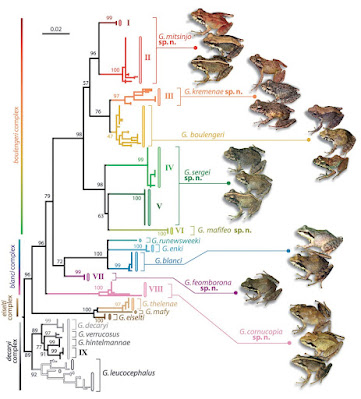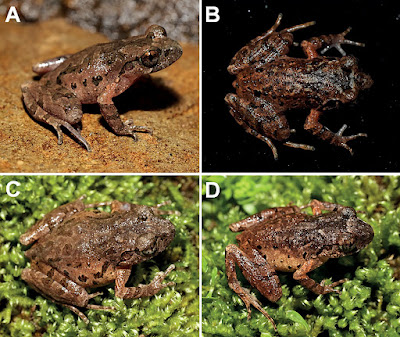 |
in Miralles, Köhler, Glaw, Valero, Crottini, ... et Vences, 2023. SALAMANDRA. 59(1) |
Abstract
The Malagasy genus Gephyromantis contains 51 species of primarily terrestrial or scansorial frogs. Although many species are morphologically weakly divergent from each other, the combination of molecular and bioacoustic evidence has led to a continuous flow of species discoveries in the last years. Previous works have notably shown the existence of numerous additional deep mitochondrial lineages of uncertain status in the nominal subgenus Gephyromantis, some of these considered as confirmed or unconfirmed candidate species, some as deep conspecific lineages. Here we use DNA sequences of one mitochondrial and one nuclear marker, as well as morphological and bioacoustic data, to conduct an integrative revision of the subgenus Gephyromantis. The analyses reveal at least 12 distinct and independent evolutionary lineages belonging to the G. blanci and G. boulengeri species complexes. Evidence for the species status of these lineages included multiple cases of syntopic occurrence without genetic admixture, as well as differences in advertisement calls or morphological differentiation without intermediate forms, suggesting reproductive isolation. We discuss the relevance of these different lines of evidence and describe six new species of Gephyromantis.
Key words. Amphibia, Anura, Gephyromantis mitsinjo sp. n., G. kremenae sp. n., G. sergei sp. n., G. mafifeo sp. n., G. feomborona sp. n., G. cornucopia sp. n., bioacoustics, taxonomy, phylogeny.
Aurélien Miralles, Jörn Köhler, Frank Glaw, Katharina C. Wollenberg Valero, Angelica Crottini, Gonçalo M. Rosa, Louis du Preez, Philip-Sebastian Gehring, David R. Vieites, Fanomezana M. Ratsoavina and Miguel Vences. 2023. An Endless Harvest: Integrative Revision of the Gephyromantis boulengeri and G. blanci Complexes reveals Six New Species of Mantellid Frogs from Madagascar. SALAMANDRA. 59(1): 1–41.
isyeb.mnhn.fr/fr/actualites/il-reste-encore-tant-despeces-decouvrir-lexemple-des-grenouilles-de-madagascar-8928






































